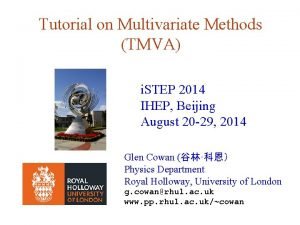TMVA 4 Toolkit for Multivariate Data Analysis in

- Slides: 1

TMVA 4 – Toolkit for Multivariate Data Analysis in TMVA core developer team: A. Höcker, P. Speckmayer, J. Stelzer, J. Therhaag, E. v. Törne, H. Voss ROOT TMVA provides a large set of sophisticated multivariate analysis techniques for both classification and regression tasks in HEP. All methods are embedded in a powerful yet user-friendly framework capable of handling the preprocessing of the input data as well as the evaluation and comparison of the MVA algorithms. TMVA is fully integrated in the popular ROOT data analysis framework. var 1 TTree/ ASCII input files meta-methods preprocessing Apply preselection • Individual cuts for different event classes are supported Generalized boosting var 2: =z[3] var. Sin: =sin(x)+3*y Data input Use event weights Transformations • Supports event-by-event weights, weights for individual files/trees and weights for different classes • Supports individual transf. for each method • TMVA 4 can not only boost decision trees, but any MVA method available original • Ensemble of “weak learners” often outperforms complicated algorithms • Transformations can be chained Classifier combination • NEW: Transformation of variable subsets • Supports TTree and ASCII files • TMVA 4 can use different methods in different parts of the input phase-space, taking into account characteristic features of the underlying data decorrelation • TMVA knows: • Supports arrays • Normalisation • Any combination or function of input variables is possible • Decorrelation • Combine all methods to obtain a powerful meta-method which is optimally adjusted to the problem • Principal component analysis Gaussianization • Gaussianisation classification R {C 1, …, CM} …to separate into classes NEW: Multiclassification Output distribution for signal and background, each for training and testing to detect overtraining RN Scan over classifier output variable values creates set of (εsig, 1 -εbkgd) points -> ROC curves Condense all information …cut on the classifier … ss H 0 x 1 R (RM) y y 2 y 3 Use all information… x 1 y H 1 regression Multiple input variables …to one classifier output… x 2 x 3 … x. N … to predict the value of one (or more) dependent variable(s) Example: Estimation of target as a function of two variables evaluation & assessment TMVA provides many evaluation macros to produce plots and numbers which help the user to decide on the best classifier and settings for an analysis Correlation Matrices for the input variables ROC curve describes performance of a binary classifier by plotting the false positive vs. the true positive fraction “lim giv it” in R en by OC c like urv be l e iho t er d ra go cla tio od s ra cla sif nd ica s om sif tio ica gu n tio es n sin g 1 - ebackgr. 1 0 0 esignal Show average quadratic deviation of true and estimated value for both training a and testing Inspect the neuronal network dd Working Point: Find optimal cut on a classifier output (=optimal point on ROC curve) depending on the problem: ◦ Cross section measurement: maximum of S/√(S+B) ◦ Signal Search: maximum of S/√(B) ◦ Precision measurement: high purity ◦ Trigger selection: high efficiency Monitor the convergence of the neuronal network training Parallel coordinates (give a feeling of the variable correlations) 1 False positive (type 1 error) : classify background event as signal -> loss of purity False negative (type 2 error) : fail to identify a signal event as such -> loss of efficiency • Many MVA methods implemented • One common platform/interface for all MVA methods • Wide range of data preprocessing capabilities • Common input and analysis framework (ROOT scripts) • Train and test all methods on same data sample and evaluate consistently Display the estimated likelihood PDFs for signal and background Show estimated value minus true value as a function of the true value Show rarity distribution Inspect the BDT summary & new developments • Automatic tuning of MVA methods to assist the user and optimize performance TMVA classifier overview Criteria no / linear correlations Performance nonlinear correlations Training Speed Response Overtraining Robustness Weak input variables Cuts Likelihood PDERS/ k-NN H-Matrix Fisher MLP BDT Rule. Fit SVM / • Cross validation to make optimal use of the available input data • Multiclass option for all methods • Flexible variable transformations • Extended set of example scripts to familiarize the user with the features and options of TMVA

